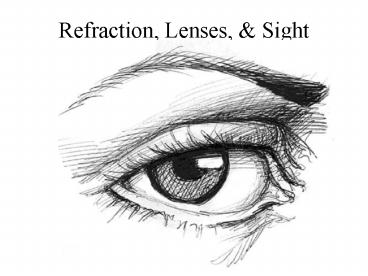Refraction, Lenses, - PowerPoint PPT Presentation
Title:
Refraction, Lenses,
Description:
... the red rays have turned through a smaller angle than ... parallel to the principal axis of a converging lens will ... Human Eye The Human Eye Normal ... – PowerPoint PPT presentation
Number of Views:109
Avg rating:3.0/5.0
Title: Refraction, Lenses,
1
Refraction, Lenses, Sight
2
Refraction
- The change in direction of a wave as is crosses
the boundary between two media in which the wave
travels at different speeds.
3
Index of Refraction
4
Snells Law
5
Index of Refraction
6
Dispersion
- The separation of light into colors arranged
according to their frequency, by interaction with
a prism or diffraction grating.
7
Rainbows
- White light separates into different colors
(wavelengths) on entering the raindrop because
red light is refracted by a lesser angle than
blue light. On leaving the raindrop, the red rays
have turned through a smaller angle than the blue
rays, producing a rainbow.
8
(No Transcript)
9
Lenses
10
Converging Lens
11
Rules For Converging Lenses
- Any incident ray traveling parallel to the
principal axis of a converging lens will refract
through the lens and travel through the focal
point on the opposite side of the lens. - Any incident ray traveling through the focal
point on the way to the lens will refract through
the lens and travel parallel to the principal
axis. - An incident ray which passes through the center
of the lens will in effect continue in the same
direction that it had when it entered the lens.
12
Image Formation by Converging Lens
13
Diverging Lens
14
Rules For Diverging Lenses
- Any incident ray traveling parallel to the
principal axis of a diverging lens will refract
through the lens and travel in line with the
focal point (i.e., in a direction such that its
extension will pass through the focal point). - Any incident ray traveling towards the focal
point on the way to the lens will refract through
the lens and travel parallel to the principal
axis. - An incident ray which passes through the center
of the lens will in effect continue in the same
direction that it had when it entered the lens.
15
Diverging Lens Image Formation
Always Virtual, Smaller, and Right-Side Up
16
(No Transcript)
17
The Human Eye
18
The Human Eye
19
Normal Eye Focus
20
Near-Sighted (Myopia)
21
Far-Sighted (Hypermetropia)
22
Astigmatism
- Cornea is oval shaped instead of spherical. This
causes light to focus on two or more spots.
23
LASIK
- Laser-assisted In Situ Keratomileusis































